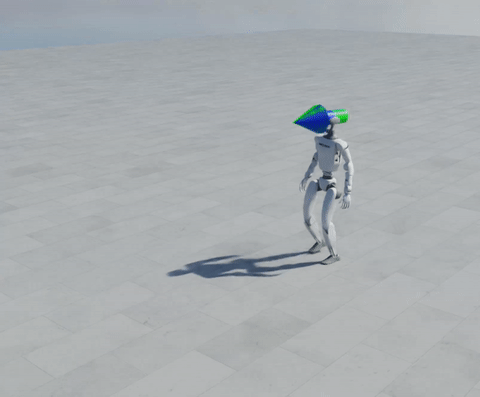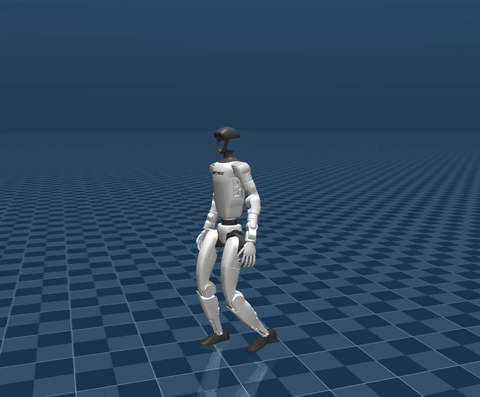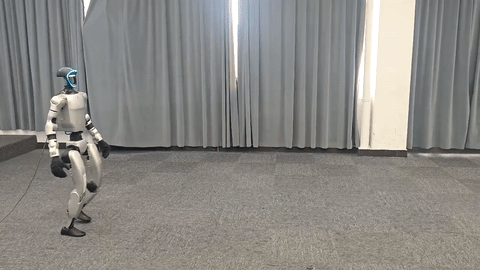This project provides a set of reinforcement learning environments for Unitree robots, built on top of IsaacLab.
Currently supports Unitree Go2, H1 and G1-29dof robots.
-
Install Isaac Lab by following the installation guide.
-
Install the Unitree RL IsaacLab standalone environments.
-
Clone or copy this repository separately from the Isaac Lab installation (i.e. outside the
IsaacLabdirectory):git clone https://github.com/unitreerobotics/unitree_rl_lab.git
-
Use a python interpreter that has Isaac Lab installed, install the library in editable mode using:
conda activate env_isaaclab ./unitree_rl_lab.sh -i # restart your shell to activate the environment changes.
-
-
Download unitree robot description files
Method 1: Using USD Files
-
Download unitree usd files from unitree_model, keeping folder structure
git clone https://huggingface.co/datasets/unitreerobotics/unitree_model
-
Config
UNITREE_MODEL_DIRinsource/unitree_rl_lab/unitree_rl_lab/assets/robots/unitree.py.UNITREE_MODEL_DIR = "</home/user/projects/unitree_usd>"
Method 2: Using URDF Files [Recommended] Only for Isaacsim >= 5.0
- Download unitree robot urdf files from unitree_ros
git clone https://github.com/unitreerobotics/unitree_ros.git - Config
UNITREE_ROS_DIRinsource/unitree_rl_lab/unitree_rl_lab/assets/robots/unitree.py.UNITREE_ROS_DIR = "</home/user/projects/unitree_ros/unitree_ros>" - [Optional]: change robot_cfg.spawn if you want to use urdf files
-
-
Verify that the environments are correctly installed by:
-
Listing the available tasks:
./unitree_rl_lab.sh -l # This is a faster version than isaaclab -
Running a task:
./unitree_rl_lab.sh -t --task Unitree-G1-29dof-Velocity # support for autocomplete task-name # same as python scripts/rsl_rl/train.py --headless --task Unitree-G1-29dof-Velocity
-
Inference with a trained agent:
./unitree_rl_lab.sh -p --task Unitree-G1-29dof-Velocity # support for autocomplete task-name # same as python scripts/rsl_rl/play.py --task Unitree-G1-29dof-Velocity
-
After the model training is completed, we need to perform sim2sim on the trained strategy in Mujoco to test the performance of the model. Then deploy sim2real.
# Install dependencies
sudo apt install -y libyaml-cpp-dev libboost-all-dev libeigen3-dev libspdlog-dev libfmt-dev
# Install unitree_sdk2
git clone git@github.com:unitreerobotics/unitree_sdk2.git
cd unitree_sdk2
mkdir build && cd build
cmake .. -DBUILD_EXAMPLES=OFF # Install on the /usr/local directory
sudo make install
# Compile the robot_controller
cd unitree_rl_lab/deploy/robots/g1_29dof # or other robots
mkdir build && cd build
cmake .. && makeInstalling the unitree_mujoco.
- Set the
robotat/simulate/config.yamlto g1 - Set
domain_idto 0 - Set
enable_elastic_handto 1 - Set
use_joystckto 1.
# start simulation
cd unitree_mujoco/simulate/build
./unitree_mujoco
# ./unitree_mujoco -i 0 -n eth0 -r g1 -s scene_29dof.xml # alternativecd unitree_rl_lab/deploy/robots/g1_29dof/build
./g1_ctrl
# 1. press [L2 + Up] to set the robot to stand up
# 2. Click the mujoco window, and then press 8 to make the robot feet touch the ground.
# 3. Press [R1 + X] to run the policy.
# 4. Click the mujoco window, and then press 9 to disable the elastic band.You can use this program to control the robot directly, but make sure the on-borad control program has been closed.
./g1_ctrl --network eth0 # eth0 is the network interface name.This repository is built upon the support and contributions of the following open-source projects. Special thanks to:
- IsaacLab: The foundation for training and running codes.
- mujoco: Providing powerful simulation functionalities.
- robot_lab: Referenced for project structure and parts of the implementation.
- whole_body_tracking: Versatile humanoid control framework for motion tracking.






